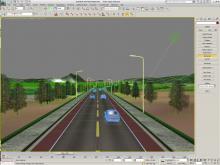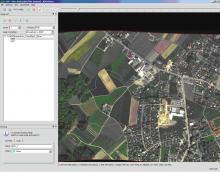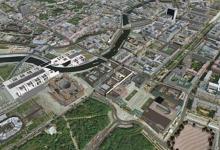The latest construction software developments can speed the construction process overall, Adrian Greeman reports Construction software is by its very nature a very fast moving technology, with new systems coming to the market almost continuously. There are some key developments however, such as major new product launches and market trends. One of the most important developments in the road design sector is the launch of the Bentley Systems V8i versions of its software, including its road design applications

The latest construction software developments can speed the construction process overall, Adrian Greeman reports
Construction software is by its very nature a very fast moving technology, with new systems coming to the market almost continuously. There are some key developments however, such as major new product launches and market trends.One of the most important developments in the road design sector is the launch of the
The key to the whole launch and its marketing focus is both inter-operability and intra-operability, explained the firm's Chief Technical Officer Keith Bentley. A special data exchange engine has been created which fits into the applications to allow them to pass on their file information directly without data loss. For applications falling outside the Bentley portfolio because of legacy use or preference, the range of formats and data files which can be exchanged has been much increased to give inter-operability, including an exchange arrangement with Autodesk to allow each to access the others detailed software controlling formats.
The commonality has two major benefits according to Bentley, allowing it to use data across the life-cycle of projects and to improve the use of collaboration tools, as well as distributing work both by discipline and geographically around the world. A new file transfer system is added to ProjectWise which reads and transmits only the changes in files to reduce transmission. An array of new features is included in the release; among them is a new capacity to use basic 3D model designs in Microstation with surface tools to manipulate designs and a generative components tool. Another key element is that all the data is intrinsically geo-coordinated.
Basic upgrades in the underlying AutoCAD tool include new navigation tools, the 'wheel' and the 'cube' which allow rapid movement and zooming on designs. The 2009 version of Civil 3D has been improved in speed and has upgraded capacities for the data it can use. The Survey Link extension is incorporated, which allows virtually all types of survey file data to be brought in. Various new strategies help to overcome the limited maximum of the DWG file that underlies the tool; these include the use of external files to store a vast quantity of surface data and the referencing of object data from other files.
A major upgrade seems likely in the next version of the software following the recent purchase by AutoDesk of licensing for Ambercore software. The Canadian company produces a 'point cloud engine' that allows handling of the vast size data files produced by LIDAR survey systems, using the reflections from laser scans. Civil 2009 also includes new capacities with three new extensions for storm water hydraulics and hydrology including storm sewer design, watershed analysis and culvert analysis. A useful tool for generating mass haul diagrams is now included.
Laser data import is also a focus for Italian road software producer SierraSoft which says it is working on a solution at present. Meanwhile it has issued a major upgrade for its suite of modular 3D road design and survey tools, particularly the Topko module for 3D modelling and survey and the ProSt for designing roads and rail. Automatic updating has been improved said Keven Corozza, Marketing Manager, "The volumes, connections between the axes, profiles and other data are linked and updated with changes." Various modules add other tools, such as the X module for junctions at grade and for 3D complexities including ramp on multi-level junctions and roundabouts. SierraSoft's suite also includes a costing module for estimating and construction accounting and a visualisation module, now integrated with the main suite.
Steady improvements are made in latest versions of
The 17.1 version of the software is much increased in its accuracy levels. This follows particularly a growing need for 3D design output to directly supply data to GPS machine control systems. These require detailed instruction at all points which means that past design approximations or unfilled points on the design, to be handled by the contractor, no longer suffice. New Land XML functionality has also been added and particularly with an eye to export data for machine control systems such as those from
McGloin said that the current version is also moving to a new way to define the road in the road wizard, which is localised for different countries and allowing them to enter local design standards, national road standards and typical cross sections used in the particular country.
One of the more unusual software offerings coming to market is the Australian Quantm package for road alignment planning, now released in Version 6.0. The system was developed in the 1990s by Australian government planners and was bought by US firm Trimble in 2006 as part of a total solution. Quantm is a mixture of software and consultancy; users from around the world buy time with the package which is held on a powerful central server in Melbourne. The main package integrates multiple physical, urban, social, property and economic data from GIS map systems and CAD files to analyse route options. Users, typically government departments, planning agencies or civil engineering consultancies, access the system with a special client program Quantm Integrator.
Once an alignment is selected the new version translates it, from a 3D spline, into a geometric form which can be imported into any favoured CAD or road design program. Trimble markets its capacity as Connected Site from Quantm, to Terramodel CAD, with data used for field survey, construction and construction machine control with various Trimble systems. Muir says that the innovative program has been used in 16 countries in the world including many states in the USA.
Simulation and analysis
Canada's
Transoft has also released an upgraded version of its sign design software, GuidSIGN, its CAD-based What You Draw Is What You Get (WYDIWYG) tool. Version 5 is a major advance according to the company, with notable new features such as a QuicDesign template system that supplies national standard templates, selected by road classification or sign designation. Users can replace the content of the template by keying in changes. Sign and content libraries within GuidSIGN have also been augmented.
The internationally known StreetMapper system for gathering ground level LIDAR to map highways, infrastructure, bridges and buildings, now has a 360º version of its vehicle mounted scanners. Like earlier versions the StreetMapper 360 vehicle mounted scan uses GPS combined with backup inertial navigation for precision in urban situations. The scanner collection was developed by the UK's
For other purposes asset survey specialist Yotta in the UK is also offering a 360º scan in its latest recording van. Yotta collects high resolution photo images for recognition software to identify, map and log street assets for local authorities. The high-tech vehicle uses a 60 megapixel panoramic camera developed by Yotta and uses Applanix satellite positioning technology to log the exact location of each image. Accuracy using combined GPS, inertial and optical tracking is around 1m.
Sweden's Simtra specialises in airport and road movement analysis. It has just launched a new R4 version of vehicle sweep path analyser PathPlanner available in a Standard and a Pro version. In the Pro version accurate simulation of movements and display of wheel tracks and swept path is supplemented with side view simulation to check vertical clearances. Presentations of multiple movements can be created and stored in a video.
From GIS provider MapInfo comes a collection of CAD type tools into its mapping and geographic data analysis package in the latest 9.5 Professional version. The much requested feature will save use of two programs for many users. Spatially aware









